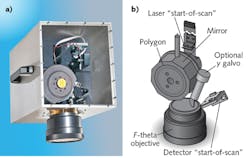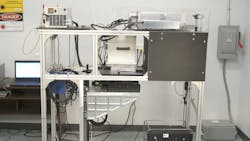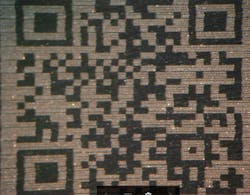Laser Printing: Low-cost, high-speed laser printing meets requirements for consumer products and industrial parts
GLENN STUTZ and KEN DZURKO
Manufacturers have generally acknowledged that package printing is an area to target for cost reduction because it provides both customer product variation and production tracking, whether using paper labels or directly onto the plastic or metallic containers. To meet this manufacturing challenge, we conducted a test study to validate the use of a new generation of high-speed pulse on demand (POD) master oscillator power amplifier (MOPA) lasers in concert with high-speed polygon scan heads. The results address the requirements from manufacturers of both consumer product goods (CPG) and industrial goods for in-line and on-demand printing with an acceptable cost and return on investment (ROI).
The targets that we investigated included direct printing onto plastics, paper, and cardboard, as well as printing on labels. Potential market segments for this printing include consumer products, medical and pharmaceutical products, universal ID (UID) packaging, and industrial products. The associated costs targeted for elimination by this printing process include consumables such as printing ink and nozzles, provisioning labor, and maintenance and repair expenses, as well as a reduction in printing lines because of higher throughput.
MOPA POD lasers
Lasers that work well with a polygon scan head have the POD feature. This is essentially a pulse picking option that allows the laser to output only when a pixel is required. Lasers that have a pulse equalizer mode in addition to POD are optimal. These lasers reliably output pulses of equal energy independent of the data stream prior to the current pulse. In addition, lasers that exhibit a higher frequency internal clock—on the order of 1 MHz or higher when used with a polygon scan head—provide for the highest speed and accuracy of pixel placement.
To reach both the performance and price targets, we used a MOPA fiber laser. The laser consists of a semiconductor seed diode joined to two sequential fiber amplifier stages in a continuously sealed fiber that requires no alignment nor maintenance. This architecture provides the agility of a low-power semiconductor laser with the high peak power and beam quality of a fiber laser, resulting in a high-speed beam source for marking. The beam quality is guaranteed by the fiber-optic waveguide, producing near diffraction-limited focal spots with high intensity needed for fast surface modification to produce the marking effect.
The MOPA laser we used in these tests is the G4 Pulsed Laser from SPI Lasers. It incorporates PulseTune technology, which provides the ability to adjust the pulse parameters (duration, peak power, repetition frequency) to meet the marking or machining susceptibility of the target material. It provides a flexible laser source at an economic price point.
The 2 MHz, 50 W EP-S-J model features good beam quality, high pulse repetition frequency, and high peak power, attributes that match well with the high-speed scan rates of the polygon scanner technology. The optical train of fiber optic components is sealed in a compact, air-cooled platform, eliminating the need for optical setup or maintenance.
High-speed polygon scan head
The scan head used to achieve the speed, accuracy, contrast and cost targets is the POLYtek high speed polygon scan head from Lincoln Laser. This general-purpose, configurable scan head includes an integral controller and marking software that is similar to conventional galvanometer-based scan heads. The key component of this scan head-which allows for high-speed printing of pixels—is a multi-faceted polygonal mirror that spins up to 4000 rpm. Line spacing for adjacent lines in the Y directions is provided by using either the integral galvanometer option or a translation device such as a moving stage.
The system operates in a raster scan mode, with the polygonal scanner providing the high-speed x-axis and the galvanometer providing the low-speed y-axis. The internal Cambridge Technology galvanometer provides for the movement of the printed file contents to the next line, thereby eliminating the need for an external stage to move the target.
The spot overlap can be controlled separately in each axis. For this testing, the POLYtek high-speed polygon scan head used a 10-facet polygon mirror and a replaceable 150 mm focal length scan lens that produces a 25 μm 1/e2 spot size on the target. The scan head is configurable with an optical aperture up to 15 mm in diameter and f-theta scan lenses ranging from 70 to 350 mm focal length as well as polygon mirrors ranging from 10 to 14 facets based on the application requirements. Figure 1 depicts the internal view of the scan head.
Winlase controller software outputs data in a raster mode via timing signals driven by the polygon scan head in coordination with an incorporated start-of-scan subsystem. This utility synchronizes the data stream with the position of the polygon mirror. Velocity stability as well as low jitter control is achieved in the X line scan axis via a motion controller.
The most common wavelengths used for marking plastics, metals, and paper are 10.6 μm and 1064 nm—the process involved in marking/printing with these wavelengths is thermal in nature.1 The laser energy is absorbed by the target and the local heating causes the mark by bleaching, carbonizing, or ablating the material. In our tests, the MOPA 1064 nm laser was used with a repetition rate of up to 2 MHz, a focal length of 250 mm, and a field size of 20 × 20 mm.
Test methodology
The testing lab was set up at the Laser Mark's (San Jose, CA; www.laser-marks.com) facility to model the characteristics and physical parameters of the actual production floor for on-demand and in-line printing directly onto plastic containers or package materials. The MOPA laser was mounted to the top of the frame (see Fig. 2). This laser is capable of producing 9 ns pulses with 70 μJ at repetition rates up to 2 MHz. The average power of the device is 50 W.The repetition rate of the laser was optimized to adjust the pulse energy to achieve the optimum contrast mark. Laser output is provided to the high-speed polygon scan head using two 90° folding mirrors. A beam expander is used between the second fold mirror and the scan head to increase the beam size entering the scan head.
To make the test comparable to printing a typical ink jet-derived image, a representative QR code was printed as well as some text. Figure 3 shows an example of the content that was uploaded into the OS program of the scan head in a bitmap (.bmp) file format based on 300 dpi resolution. The goal was to print the complete image in 0.2 sec.Test results
After performing iterative trial passes where the repetition rates and laser power levels were adjusted, a suitable printed image in the target time was printed on a repeatable basis. These printed images were easily readable by the naked eye from a distance of 12 in., and the QR code was readable by a typical handheld QR code reading application (see Fig. 4).The optimum spot size on the target was approximately 25 μm 1/e2. To achieve the desired contrast on the target, a pulse energy of approximately 70 μJ was required with higher energy available. With the use of complementary additives, a reduction in the required laser energy can result in higher marking speeds and increased contrast with optimal print character color.2
Consideration of spot size, focal length, and polygon mirror specifics, as well as optimization of the content file and configuration of the MOPA laser, may be required to attain these printing parameters. The pixel placement repeatability for this image is ±20 μm in the fast scan axis and ±10 μm in the slow scan axis.
The results of our test using a MOPA 1064 nm laser in combination with a high-speed polygon scan head demonstrate that we could achieve an ROI and meet print specification goals, making this technique comparable to a traditional ink jet printing line, but without consumables or UV curing-and at much greater speeds.
Flexibility is another key application consideration for marking and printing with lasers.3 A suitable MOPA laser with a high-speed polygon scan head provides print speeds that allow for in-line and on-demand printing of variable information, either directly onto the target or onto labels.
REFERENCES
1. J. Heller, "Precision laser marking for medical applications," Industrial Laser Solutions for Manufacturing, 30, 6, 28-30 (Nov/Dec. 2015).
2. S. R. Sabreen, "Laser marking plastics," Industrial Laser Solutions for Manufacturing, http://bit.ly/2hLL7C6 (Jan. 2008).
3. D. Belforte, "PhotoScribe laser enables marking of 410,000 pills per hour," Industrial Laser Solutions for Manufacturing online, http://bit.ly/1DqhC9i (Jul. 22, 2014).
Glenn Stutz is chief operating officer and chief technology officer at Lincoln Laser, Phoenix, AZ; e-mail: [email protected]; www.lincolnlaser.com, while Ken Dzurko is general manager at SPI Lasers, Santa Clara, CA; e-mail: [email protected]; www.spilasers.com.



